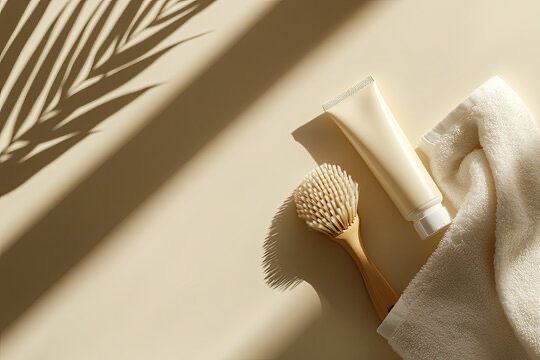Dry Brushing: Support Detox, Circulation, and Calm
- Candice Furubayashi

- Apr 25
- 2 min read
Updated: Jun 19

Dry brushing exfoliates the skin and is a foundational Ayurvedic practice that supports lymphatic drainage, boosts circulation, and helps calm the nervous system. In a world that encourages rushing, dry brushing is a way to slow down and connect with the body through intentional touch and rhythm.
Why Dry Brushing?
According to Ayurveda, the lymphatic system is one of the key pathways for removing toxins (ama) from the body. When lymph becomes stagnant often due to stress, lack of movement, or poor digestion. It can impact energy, immunity, and mental clarity. Dry brushing (traditionally known as garshana) is a simple yet powerful tool to stimulate lymph flow, promote detoxification, and restore balance.
It’s more than a physical practice. The repetitive motion provides grounding. Especially supportive for Vata and Kapha imbalances. In just a few minutes, it becomes a ritual that reconnects body and mind.
Benefits of Daily Dry Brushing
Stimulates lymphatic flow and detox pathways
Boosts circulation and improves skin texture
Gently exfoliates dead skin cells
Enhances energy and clarity
Grounds excess Vata and helps move stagnant Kapha
Encourages a calm, intentional start to the day
How to Practice
Dry brushing is best done in the morning before bathing:
Use a natural bristle brush or raw silk gloves.
Begin at the feet and brush upward in long strokes toward the heart.
Use circular motions around joints and clockwise strokes on the abdomen.
Follow with a warm shower and, if desired, apply a nourishing oil to the skin.
Brush strokes should be gentle and consistent, stimulating and supporting.
Doshic Guidelines for Dry Brushing
Dry brushing is beneficial for all doshas, but how you approach it matters:
Vata (Dry, Light, Cold)
Naturally dry and mobile, Vata types should brush gently, no more than 1–2 times per week. Use a soft-bristle brush and always follow with a warming, nourishing oil like sesame oil to calm the nervous system and replenish moisture.
Pitta (Hot, Sharp, Intense)
Pitta types benefit from moderate brushing: 2–3 times per week is enough. Use a medium-soft brush and avoid areas of irritation or inflammation. Finish with cooling oils like coconut or sunflower to soothe and balance heat.
Kapha (Heavy, Slow, Oily)
Kapha types thrive with regular dry brushing: daily or most days of the week. A firmer brush and more vigorous strokes help stimulate circulation, clear stagnation, and awaken energy. Follow with warming oils like mustard or spiced blends to invigorate.
A Rooted Ritual for Modern Wellness
Dry brushing is a low-effort, high-impact addition to any wellness routine. It supports the body’s natural detoxification systems while creating space for stillness, clarity, and daily rhythm.
At Inspire Jewel Wellness, simple, time-tested rituals like this are woven into personalized care plans to support whole-body balance. These aren’t trends... they’re tools for sustainable, lasting wellness.




Comments